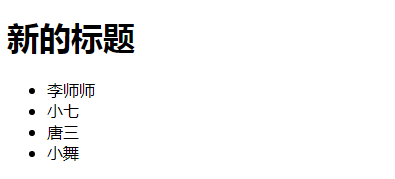概念
首先我们会用到哪些框架和工具呢?
React
UI框架
Redux
状态管理工具,与React没有任何关系,其他UI框架也可以使用Redux
react-redux
React插件,作用:方便在React项目中使用Redux
react-thunk
中间件,作用:支持异步action
目录结构
Tips:与Redux无关的目录已省略
|
1
2
3
4
5
6
7
8
9
|
|--src |-- store Redux目录 |-- actions.js |-- index.js |-- reducers.js |-- state.js |-- components 组件目录 |-- Test.jsx |-- index.js 项目入口 |
准备工作
第1步:提供默认值,既然用Redux来管理数据,那么数据就一定要有默认值,所以我们将state的默认值统一放置在state.js文件
|
1
2
3
4
5
6
7
8
9
10
11
12
13
14
15
16
17
|
/** * 步骤一 * state.js * 设置默认值 * yarn add redux * yarn add react-redux * yarn add redux-thunk */// 声明默认值// 这里我们列举两个示例// 同步数据:pageTitle// 异步数据:infoList(将来用异步接口获取)export default { pageTitle: '首页', infoList: []} |
第2步:创建reducer,它就是将来真正要用到的数据,我们将其统一放置在reducers.js文件
|
1
2
3
4
5
6
7
8
9
10
11
12
13
14
15
16
17
18
19
20
21
22
23
24
25
26
27
28
29
30
31
32
33
34
35
36
|
/** * 步骤二 * reducers.js * 创建 reducer */// 工具函数,用于组织多个reducer,并返回reducer集合import { combineReducers } from 'redux';// 默认值import defaultState from './state.js';// 一个reducer就是一个函数function pageTitle (state = defaultState.pageTitle, action) { // 不同的action有不同的处理逻辑 switch (action.type) { case 'SET_PAGE_TITLE': return action.data default: return state }}function infoList (state = defaultState.infoList, action) { switch (action.type) { case 'SET_INFO_LIST': return action.data default: return state }}// 导出所有reducerexport default combineReducers({ pageTitle, infoList}) |
第3步:创建action,现在我们已经创建了reducer,但是还没有对应的action来操作它们,所以接下来就来编写action
|
1
2
3
4
5
6
7
8
9
10
11
12
13
14
15
16
17
18
19
20
21
22
23
24
25
26
27
28
29
30
31
32
33
34
35
36
37
38
39
|
/** * 步骤三 * actions.js * 创建action */// action也是函数export function setPageTitle (data) { return (dispatch, getState) => { dispatch({ type: 'SET_PAGE_TITLE', data: data }); }}export function setInfoList (data) { return (dispatch, getState) => { // 测试接口 let url = 'http://localhost:8000/user'; // 使用fetch实现异步请求 window.fetch(url, { method: 'GET', headers: { 'Content-Type': 'application/json' } }).then(res => { return res.json() }).then(data => { let { code, data } = data if(code === 0){ dispatch({ type: 'SET_INFO_LIST', data: data }) } }) }} |
最后一步:创建store实例
|
1
2
3
4
5
6
7
8
9
10
11
12
13
14
15
16
17
18
19
20
21
22
23
24
25
26
27
28
|
/** * 步骤四 * index.js * 创建store实例 */// applyMiddleware: redux通过该函数来使用中间件// createStore: 用于创建store实例import { applyMiddleware, createStore } from 'redux';/** * 中间件 * 作用:如果不使用该中间件,当我们dispatch一个action时,需要给dispatch函数传入action对象; * 但如果我们使用了这个中间件,那么就可以传入一个函数,这个函数接收两个参数:dispatch和getState。 * 这个dispatch可以在将来的异步请求完成后使用,对于异步action很有用 */import thunk from 'redux-thunk';// 引入reducerimport reducers from './reducers.js';// 创建store实例let store = createStore( reducers, applyMiddleware(thunk))export default store |
至此,我们已经完成了所有使用Redux的准备工作,接下来就在React组件中使用Redux
开始使用
首先,我们来编写应用的入口文件index.js
|
1
2
3
4
5
6
7
8
9
10
11
12
13
14
15
16
17
18
19
20
21
22
23
24
25
26
27
28
29
30
31
|
/** * 入口文件 * index.js */import React from 'react';import ReactDOM from 'react-dom';// 引入组件import TestComponent from './components/Test.jsx';/** * Provider是react-redux两个核心工具之一 * 作用: 将store传递到每个项目中的组件中 */// 第二个工具是connectimport { Provider } from 'react-redux';// 引入创建好的store实例import store from './store/index.js';// 渲染DOMReactDOM.render( ( <div> {/*将store作为prop传入,即可使应用中的所有组件使用store*/} <Provider store={store}> <TestComponent /> </Provider> </div> ), document.getElementById('root')); |
最后是我们的组件:Test.jsx
|
1
2
3
4
5
6
7
8
9
10
11
12
13
14
15
16
17
18
19
20
21
22
23
24
25
26
27
28
29
30
31
32
33
34
35
36
37
38
39
40
41
42
43
44
45
46
47
48
49
50
51
52
53
54
55
56
57
58
59
60
61
62
63
64
65
66
67
68
69
70
71
72
73
74
75
76
77
78
79
80
81
82
83
84
85
|
/** * 测试页面 * Test.jsx */import React, { Component } from 'react';// connect方法的作用:将额外的props传递给组件,并返回新的组件,组件在该过程中不会受到影响import { connect } from 'react-redux';// 引入actionimport { setPageTitle, setInfoList } from '../store/actions.js';class Test extends Component { // 构造器 constructor(props) { super(props); this.state = {}; } // 生命周期--组件加载完毕 componentDidMount () { // 组件传值 let { setPageTitle, setInfoList } = this.props; // 触发setPageTitle action setPageTitle('新的标题'); // 触发setInfoList action setInfoList(); } render() { // 通过mapStateToProps的映射,从props中解钩store let { pageTitle, infoList } = this.props; // 使用 store return ( <div> <h1>{pageTitle}</h1> { infoList.length > 0 ? ( <ul> { infoList.map((item, index) => { return ( <li key={item.id}>{item.name}</li> ) }) } </ul> ):null } </div> ); }}// mapStateToProps:将state映射到组件的props中const mapStateToProps = (state) => { return { pageTitle: state.pageTitle, infoList: state.infoList }}// mapDispatchToProps:将dispatch映射到组件的props中const mapDispatchToProps = (dispatch, ownProps) => { return { setPageTitle (data) { // 如果不懂这里的逻辑可查看前面对redux-thunk的介绍 dispatch(setPageTitle(data)) // 执行setPageTitle会返回一个函数 // 这正是redux-thunk的所用之处:异步action // 上行代码相当于 /*dispatch((dispatch, getState) => { dispatch({ type: 'SET_PAGE_TITLE', data: data }) )*/ }, setInfoList (data) { dispatch(setInfoList(data)) } }} export default connect(mapStateToProps, mapDispatchToProps)(Test) |
Redux三大原则
- 单一数据源
整个应用的 state 被储存在一棵 object tree 中,并且这个 object tree 只存在于唯一一个 store 中 - State 是只读的
唯一改变 state 的方法就是触发 action,action 是一个用于描述已发生事件的普通对象 - 使用纯函数来执行修改
为了描述 action 如何改变 state tree ,你需要编写 reducers
结语
以上就是在React项目中使用Redux的简单示例,文中代码可能会有编写错误,欢迎指正,同事希望本文对大家有所帮助
参考
效果图
